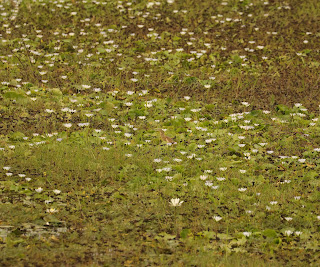After our late night at the Carpe Diem Resort, it was good to hear that we were going to have a later start than normal the following morning. Niall had arranged with the Resort that we would have breakfast at 07:00, with the 4WD loaded & ready to go before breakfast. The only problem was the Resort manager hadn't remembered to tell the breakfast team. They were in the kitchen at that time, but the buffet food didn't arrive till after 08:00. The food was good when it finally appeared. But had we known that it was going to take so long, we would have been better with another packed breakfast and an earlier departure.
Kelp Gull: A variety of ages were resting in the bay. This is the vetula subspecies and the same subspecies as the individual that appeared in the UK in Aug 22 as the first UK record
The main reason for having breakfast before we left, was it would be another day with a lot of driving. Our next destination was Conda which is the base for accessing the remaining bits of the Kumbira Forest. This was around 175 miles away: around a four hour drive. But we had a few ad-hoc Birding stops along the way to break up the drive, whilst lengthening its duration. The first Birding stop was a roadside Water Lily covered marsh: about a half hour South of the Carpe Diem Resort.
Squacco Heron: This is a widespread, but local, Heron that occurs across the Southern Palearctic region, Africa & Madagascar
African Jacana: This is the commoner Jacana species in Africa & it occurs on lakes, ponds & marshes of Sub-Saharan Africa
It was an easily forgettable journey, apart from these patches of tree-sized Succulents near the start.
As we continued South, we saw more areas of grassland: These apparently barren areas have been cleared of any native bush and will be regularly burnt by the villagers to promote new grass: they will be an ecological disaster for the wildlife that used to live there
The area had regular rocky outcrops: They were large enough to provide some shelter from the fires to allow trees to grow
Corn Cricket: This is a three inch long armoured Cricket that looks indestructible. Niall said they are common in South Africa
As we got closer to Conda, we turned off onto a side road to the town of Gabela. We passed through Gabela and carried on to a cultivated valley with some small patches of trees. Niall had seen Gabela Bushshrike, which is an Angola range-restricted endemic in this area. We spent an hour seeing very little in the early afternoon. Niall reckoned we might struggle to see the Gabela Bushshrike at Kumbira Forest, so it had been worth the significant diversion. Sadly, it wasn't an inspiring Birding site & I was happy when we moved on towards Kumbira Forest. The one saving grace is we knew Niall's backup site had failed, so when we struggled to see one at Kumbira Forest, we knew we needed to keep looking there.
It was mid-afternoon when we finally arrived at Conda: the nearest town to the Kumbira Forest area. But that is only near when looking on a map. The tracks into the forested areas are very bad & heavily rutted in parts, with driving speeds in the worst areas being down to slower than a walking speed. Fortunately, we were visiting in the dry season and we could still drive in. It must be hard to get as far into the remaining patches of the forest in a 4WD during the middle of the wet season, with a lot of walking from the first of the heavily rutted areas. We stopped, soon after we started driving to the Kumbira Forest. Niall said we were in an area where he had seen Pulitzer's Longbill before. We got out of the car to find an area will a little bit of remnant scrubby vegetation around some cultivated fields. Fortunately, the Pulitzer's Longbill popped into view when he tried playing a recording. It was a long-billed, large olive-green Warbler with a slim & long profile. It was also skulking in the bushes and while we saw a pair there on several occasions, I failed to get a photo of this Angolan endemic.
Coffee is an important crop for Angola: It's not too bad for wildlife as it is often grown under the shade of bigger trees
We had time for an hour or so of Birding in the Kumbira Forest, but we were up against the fading light. We saw a few species, but nothing that we weren't going to see again in the area. As the light started to go, it was time to head off to find our accommodation at the Fazenda Rio Uiri, back in Conda: it proved to be a colonial style farm with small rooms, but well trained staff & good food.














